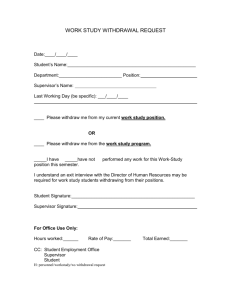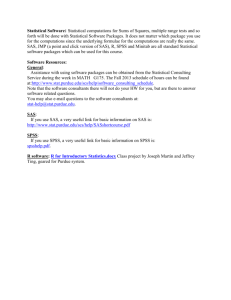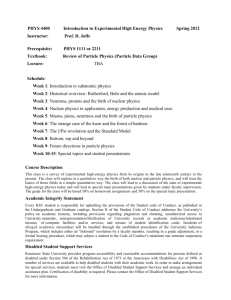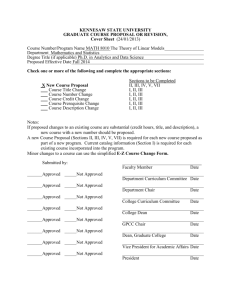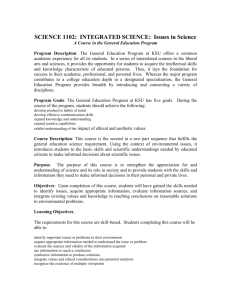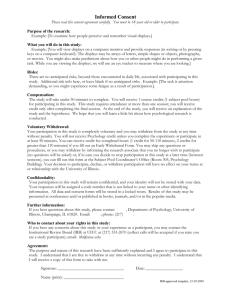Syllabus3010
advertisement
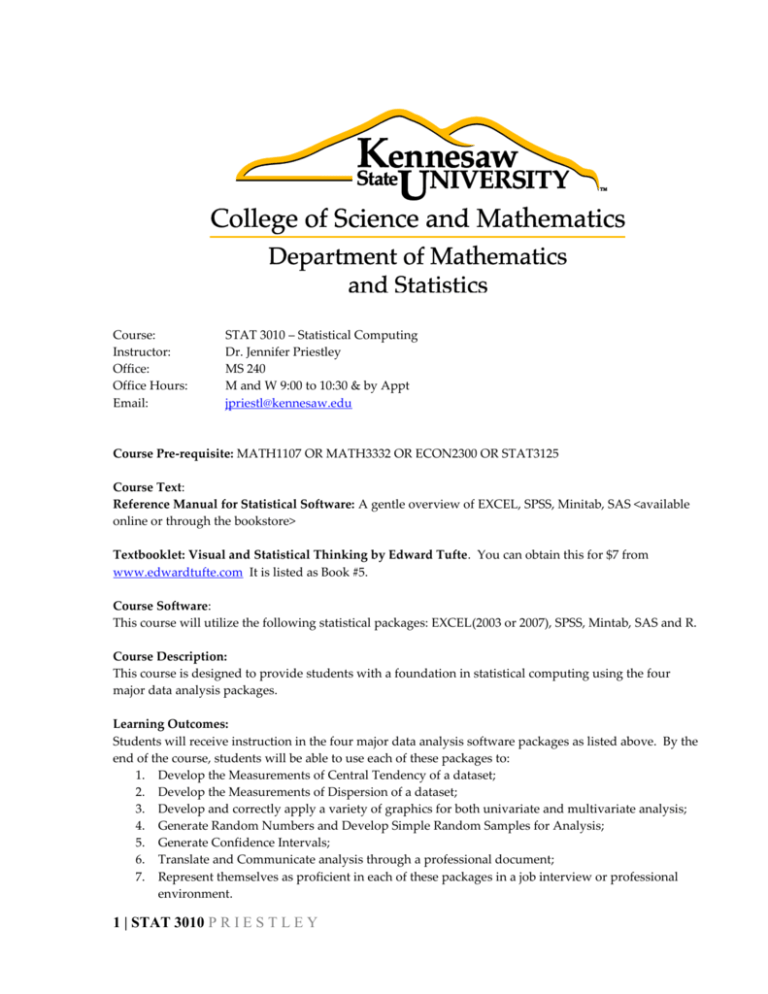
Course: Instructor: Office: Office Hours: Email: STAT 3010 – Statistical Computing Dr. Jennifer Priestley MS 240 M and W 9:00 to 10:30 & by Appt jpriestl@kennesaw.edu Course Pre-requisite: MATH1107 OR MATH3332 OR ECON2300 OR STAT3125 Course Text: Reference Manual for Statistical Software: A gentle overview of EXCEL, SPSS, Minitab, SAS <available online or through the bookstore> Textbooklet: Visual and Statistical Thinking by Edward Tufte. You can obtain this for $7 from www.edwardtufte.com It is listed as Book #5. Course Software: This course will utilize the following statistical packages: EXCEL(2003 or 2007), SPSS, Mintab, SAS and R. Course Description: This course is designed to provide students with a foundation in statistical computing using the four major data analysis packages. Learning Outcomes: Students will receive instruction in the four major data analysis software packages as listed above. By the end of the course, students will be able to use each of these packages to: 1. Develop the Measurements of Central Tendency of a dataset; 2. Develop the Measurements of Dispersion of a dataset; 3. Develop and correctly apply a variety of graphics for both univariate and multivariate analysis; 4. Generate Random Numbers and Develop Simple Random Samples for Analysis; 5. Generate Confidence Intervals; 6. Translate and Communicate analysis through a professional document; 7. Represent themselves as proficient in each of these packages in a job interview or professional environment. 1 | STAT 3010 P R I E S T L E Y Grading in this course will consist of four HW sets a final project: Grading: HW 1 <Applications in EXCEL> HW 2 <Applications in SPSS> HW 3 <Applications in SAS> Final Project <Applications in R and SAS > 20% 20% 30% 30% Notes on the Final Project: Students will need to obtain a dataset of their choice (the source needs to be provided and verifiable). The dataset will need to have AT LEAST 50 observations and five variables. The dataset must have at least two ratio scale variables and at least one categorical variable. Students will need to submit a professionally written report on the dataset, which will include: o INTRODUCTION A description of the dataset, the variables (please include a full description of EVERY variable – including quantitative or qualitative), where it came from, and why it was selected over all other potential datasets. o UNIVARIATE DATA ANALYSIS Descriptive Statistics on each of the variables (frequency table(s) for the categorical/qualitative variable(s) and measurements of central tendency and dispersion for the quantitative variable(s)). Appropriate graphical displays for single variables with particular attention to using the correct display based upon the type of variable. Commentary on what these results mean. o MULTIVARIATE DATA ANALYSIS Appropriate multivariate analysis – use a minimum of three tools – with commentary on each set of results. Appropriate multivariate graphical displays with commentary on each set of results. Pay particular attention to using the correct display based upon the type of variable(s). o SAMPLE ANALYSIS Using a Random Number Generator, extract a 20 item sample from the dataset. Develop a 95% and a 99% Confidence Interval on two of the ratio scale variables. Verify that the results of the confidence intervals contain (or not) the “population” mean from the variable as identified in the first section. Explain why (or why not) the population mean was present in the sample interval. o CONCLUSION Provide a few general comments about your findings. Identify anything about your data that you would have liked to have known, but did not know how to approach the analysis. o All CODE should be NEATLY included as Appendix 1. o Students are expected to use both SAS (and SQL) as well as R for this project. o Five students will have an opportunity to earn five points of extra credit by presenting their project to the class on the last day. These students will be accepted on a first comefirst serve basis. 2 | STAT 3010 P R I E S T L E Y POLICIES: Attendance & Assignment Policies: You are expected to attend all classes, and turn in homework sets by the due date. Late homework will NOT BE ACCEPTED. While discussion/study groups are encouraged, you are expected to do your own work on homework problems that are turned in. Withdrawal Policy…The last day to withdraw from the course and possibly receive a "W" is OCTOBER 12. Students who find that they cannot continue in college for the entire semester after being enrolled, because of illness or any other reason, need to complete an online form. To completely or partially withdraw from classes at KSU, a student must withdraw online at www.kennesaw.edu, under Owl Express, Student Services. The date the withdrawal is submitted online will be considered the official KSU withdrawal date which will be used in the calculation of any tuition refund or refund to Federal student aid and/or HOPE scholarship programs. It is advisable to print the final page of the withdrawal for your records. Withdrawals submitted online prior to midnight on the last day to withdraw without academic penalty will receive a “W” grade. Withdrawals after midnight will receive a “WF”. Failure to complete the online withdrawal process will produce no withdrawal from classes. Call the Registrar’s Office at 770-423-6200 during business hours if assistance is needed. Students may, by means of the same online withdrawal and with the approval of the university Dean, withdraw from individual courses while retaining other courses on their schedules. This option may be exercised up until October 12, 2011. This is the date to withdraw without academic penalty for Fall Term, 2011 classes. Failure to withdraw by the date above will mean that the student has elected to receive the final grade(s) earned in the course(s). The only exception to those withdrawal regulations will be for those instances that involve unusual and fully documented circumstances. Academic Integrity: Every KSU student is responsible for upholding the provisions of the Student Code of Conduct, as published in the Undergraduate and Graduate Catalogs. Section II of the Student Code of Conduct addresses the University’s policy on academic honesty, including provisions regarding plagiarism and cheating, unauthorized access to University materials, misrepresentation/falsification of University records or academic work, malicious removal, retention, or destruction of library materials, malicious/intentional misuse of computer facilities and/or services, and misuse of student identification cards. Incidents of alleged academic misconduct will be handled through the established procedures of the University Judiciary Program, which includes either an “informal” resolution by a faculty member, resulting in a grade adjustment, or a formal hearing procedure, which may subject a student to the Code of Conduct’s minimal one semester suspension requirement. Unauthorized Collaboration: Submission for academic credit of a work product, or a part thereof, represented as its being one's own effort, which has been developed in substantial collaboration with or without assistance from another person or source, is a violation of academic honesty. It is also a violation of academic honesty knowingly to provide such assistance. Collaborative work specifically authorized by a faculty member is allowed. Although I do not expect cheating, plagiarism, or 3 | STAT 3010 P R I E S T L E Y unauthorized collaboration in my classroom, the penalty is an F for the course…AND I will do everything within my power to have you dismissed from the University and the University System of Georgia. And I will tell your mother. Let me know if this is in anyway unclear. Professional Behavior Guidelines including the use of cell phones or other electronic communication devices: If you use these devices for any reason during my class, I will pick up the device, smash it into seven million pieces and spread its ashes across campus! 4 | STAT 3010 P R I E S T L E Y
